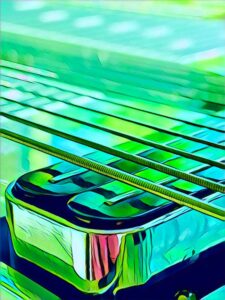As an Amazon Associate Playpedalsteel.com earns from qualifying purchases. This page contains affiliate links.
With its endless capabilities for melodic, intervallic, and harmonic expression, the E9 tuning is a prominent pedal steel tuning. The tuning lends itself well to pedal and knee lever changes, and can produce a genuine pedal steel sound that listeners really enjoy.
The E9 tuning for pedal steel is similar to a guitar’s Open E tuning, and it also has some chromatic strings as well. The tuning generally uses ten strings, and often utilizes a few foot pedals and a three or four knee levers to change the pitch of the strings mechanically.
It is heard in countless recordings all over the world (in many styles of music), and the tuning continues to pave its path in the musical world. Let’s take a closer look at the E9 tuning for pedal steel guitar…
The Functions of the E9 Tuning
When tuned from the lowest pitch to the highest pitch in the open position, the standard E9 tuning uses the notes B, D, E, F#, G#, B, E, G#, D#, and F#. The F#s, or major 9ths in the E major chord, help give the tuning its name, while the D and D# strings in the tuning are usually thought of as chromatic notes or strings.
Here’s a table that displays the exact tuning of the E9 pedal steel neck:
| String # | Note Name (At Open String) |
| 1 | F# |
| 2 | D# |
| 3 | G# |
| 4 | E |
| 5 | B |
| 6 | G# |
| 7 | F# |
| 8 | E |
| 9 | D |
| 10 | B |
When used in combination with the pedals and knee levers, there are many ways you can utilize this type of tuning.
In its most basic form, when no pedals or knee levers are engaged, the tuning provides an open major chord at any position when certain strings are voiced. If you use the 9th string, or D string, with this chord, then they can add a Dominant 7 sound to the chord.
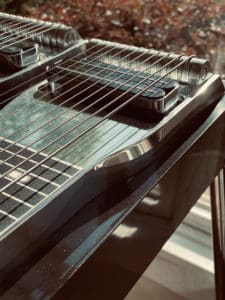
Also, as the name of the tuning suggests, the F# strings can be played with the open major chord (still no pedals or levers engaged) to add the major 9th tone to the chord.
If a player wants to add a major 7th to this chord or voicing, then they can play the 2nd string, or the D# string, another “chromatic” string that is a feature of the tuning.
All of these uses for the major chord in this position are also effective with single string playing utilizing scales, and can provide nice melodic and single string options.
Using Pedals and Knee Levers on the E9 Neck
When you use the pedals and knee levers to change the pitch of certain strings, the E9 tuning really provides many possibilities for musical expression.
By employing one or more pedals at a time, the player can quickly change the pitches of certain notes, creating different chords, notes, intervals, etc. I wrote an in-depth post about the pedals and foot levers on pedal steel if you’d like to take a deeper look at the potential they have musically.
Even without pedals you can shift positions on the fretboard with your bar, as well as pick certain strings that you’d like to voice. But with the pedals and knee levers, the E9 tuning really displays the endless ways a pedal steel can be utilized musically.
It is no wonder why many people are not only drawn to its sound, but also the way the instrument and tuning is played on the instrument.
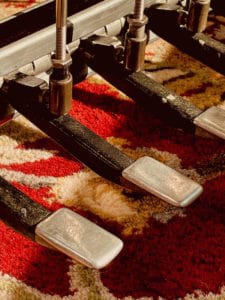
The Sound
The voicing of the E9 tuning is very recognizable when the pedals and knee levers are played in certain ways.
The change of pitches can be audible to listeners as string bending, which is often heard in many forms of country music.
Bending the notes mechanically, the pedal steel has the ability to quickly create musical effects that a guitar player usually does with their fingers.
With reverb, vibrato, and a wide frequency range, the pedal steel sounds really unique as an instrument when the pedals and levers are used.
Musical Styles and Genres
As versatile of an instrument as it is, the pedal steel can be heard in many types of music. If you’d like a little nostalgia for the ears, I wrote a post where you can listen to 11 classic songs that feature the vintage pedal steel sound.
The E9 tuning was very popular in classic country music, but now finds its home in pop, indie, rock, soul, blues, jazz, and many other genres.
Using the pedals and knee levers within the tuning is not only unique musically, but also sonically. The textures and ambience that can be created with the tuning is incredible.
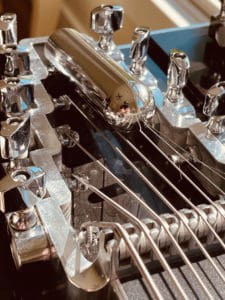
Greg Leisz and many other players have built careers out of playing this tuning, using it on recording sessions and performances with various artists and styles.
Artists and groups such as Lady Gaga, Bruce Springsteen, Daft Punk, Eric Clapton, and Wilco have sought the sound of pedal steel for some of their music.
Glissandos
Pedal steel has a distinctive ability to create glissandos, and the E9 tuning provides many options for this musical effect.
By using the pedals and knee levers combined with bar movement, smooth continuity between different chords and notes can be voiced.
You can pick notes and slide the bar, and using the pedals and knee levers, move between positions on the neck without having to reiterate the attack of the notes.
This can be used to create new chords, inversions, intervals, and more with a fluidity that is musically extraordinary. I created chord charts and scale diagrams for the E9 tuning that can be a great way to see these visually.
The sound of glissandos with the E9 neck can be beautiful, haunting, lilting, and evocative. This is especially true when a player uses vibrato, reverb, and the volume pedal to bring out the expression of the notes.
Combined with mechanical string bending, or the changing of pitches with pedals and levers, glissandos really display the E9 tuning’s possibilities.
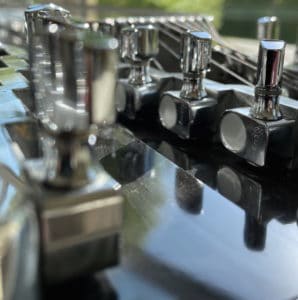
The Diatonic Aspects of the Tuning
When the chromatic strings aren’t played, the tuning is very similar to open tunings on other instruments. Bottlenecks slide tunings and dobro tunings are good examples of this similarity.
Oftentimes, you can stay in a single position on the neck, and using the pedals and knee levers alone, move diatonically between chords in a key.
For example, if you play at the third fret, and don’t hit any of the chromatic strings, you can move between the G major, A minor, B minor, C major, D major, and E minor chords in the key of G.
When you add in the chromatic strings to these diatonic chords, all kinds of extensions and different chords are possible in one position.
This shows that even without a lot of bar movement, the pedals and levers provide so many musical options within the E9 tuning.
Conclusion
Between the specific uses of its pedals and knee levers, its chromatic strings, and its particular sound, the E9 tuning has much to offer for players and musical artists.
As pedal steel continues to evolve in music, it will be interesting to see how the E9 neck will too. The tuning is complex, yet intuitive, and has a lot of potential that remains to be tapped into.
Thanks for checking out this page, hope it is helpful and makes playing more enjoyable! If you’re interested in diving deeper into playing E9 pedal steel, check out these resources and guides…
The Chord Guide for E9 Pedal Steel (E-Book, Digital Download)
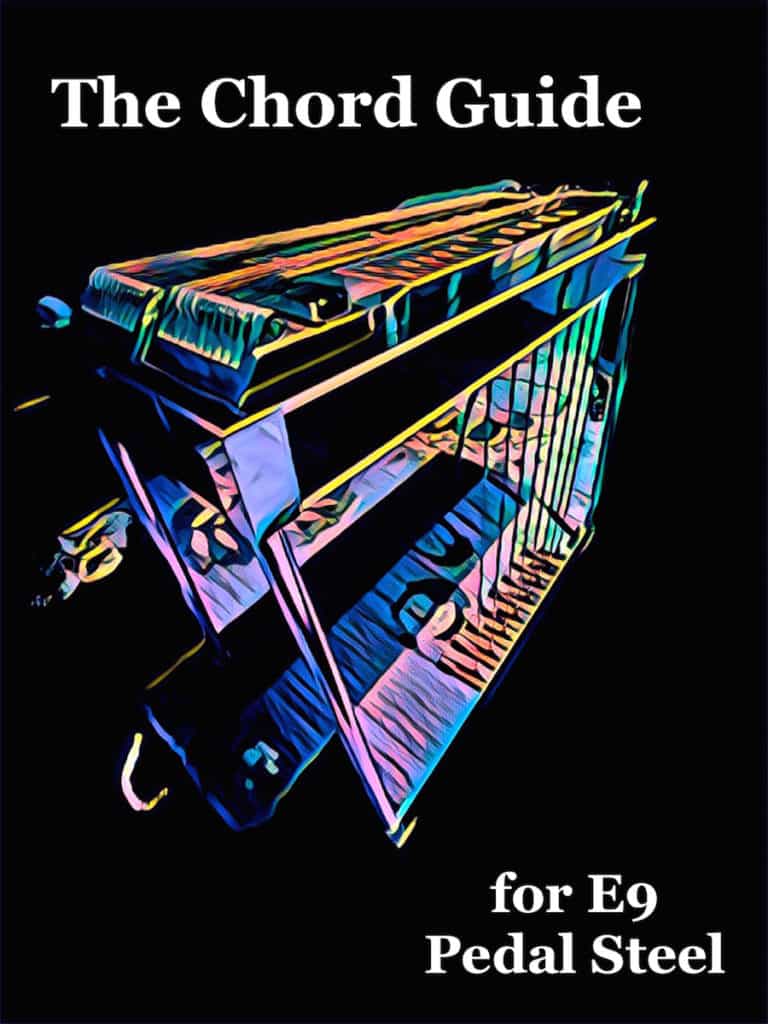
Learn the chords on the E9 neck in a way that makes playing simple and enjoyable…
- Almost Every Chord You’ll Ever Need for E9
- Intuitive and Easy to Use
- Make Use of Pedal and Lever Combinations
- Example Tabs of Chord Movements
- Easily Utilize the Nashville Number System
- Great For Any Key and Style of Music
Includes a bonus section of over a hundred pages of extra chord charts, key references, and more!
You may also like…
200 Country Riffs & Licks for E9 Pedal Steel
Add these country licks to your playing repertoire…
- Easy to Read Format
- Includes Rhythmic Notation
- Playing Over Chord Changes
- Great for Country, Alt-Country, & Honky-Tonk Styles
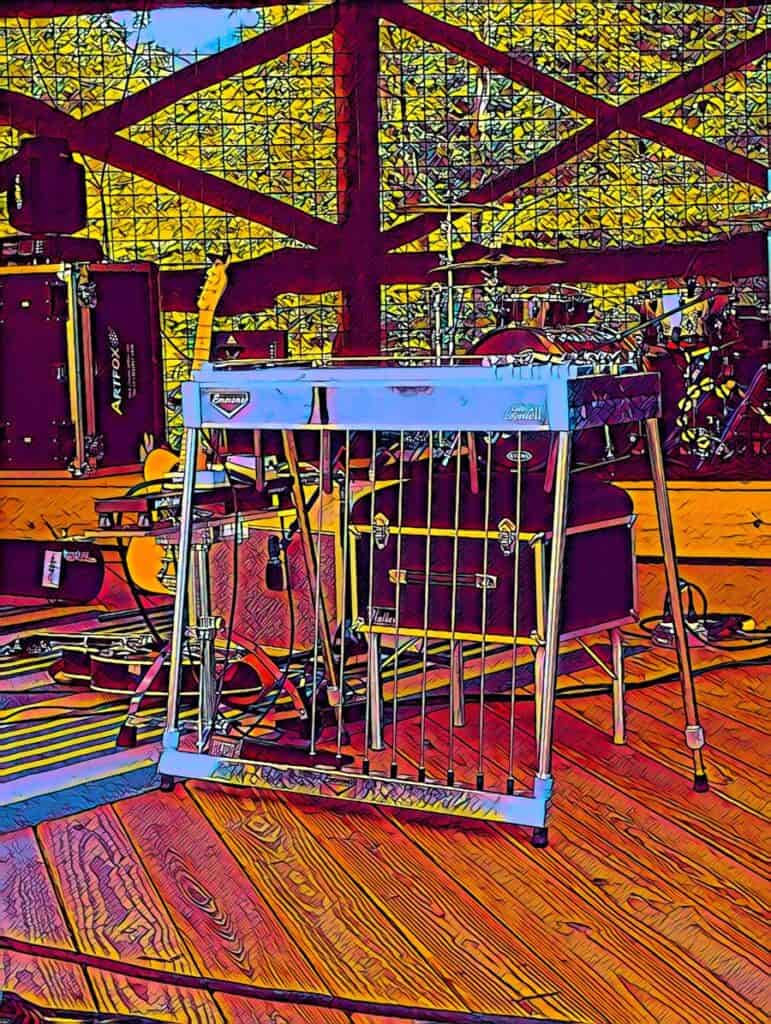
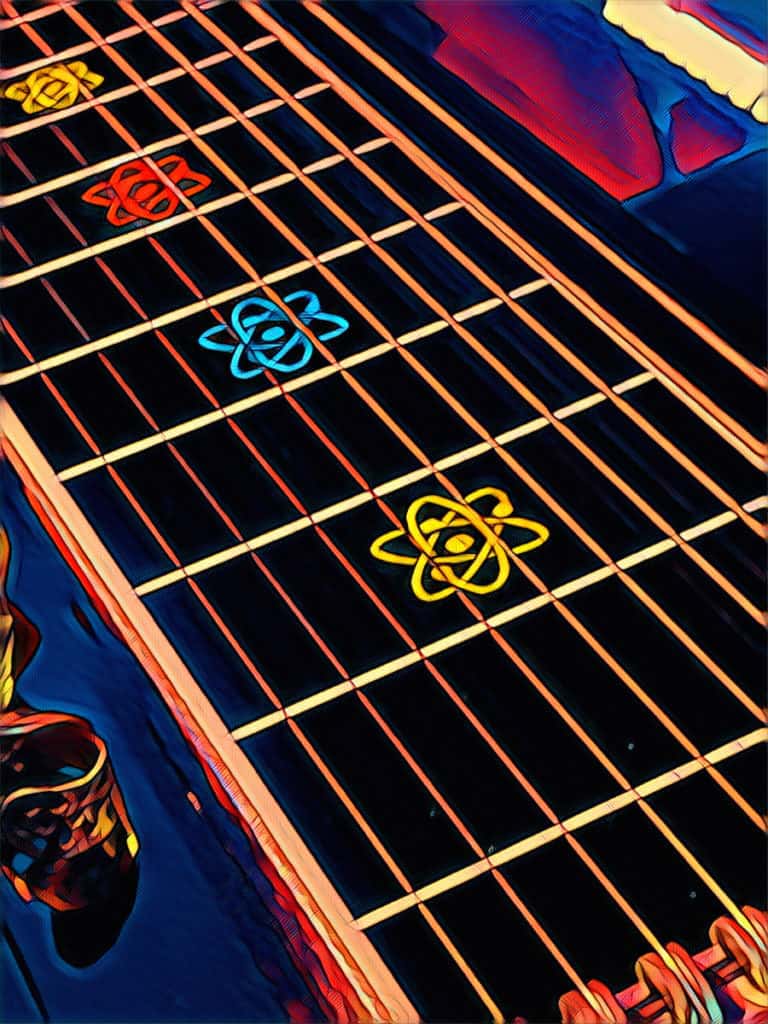
The Scale Book for E9 Pedal Steel
Over 1,000 Pages with Tabs and Diagrams!
- Easy to Use Reference for Practicing
- All Major and Minor Pentatonic Scales, Modes, Major Scales
- All Keys, and Covers the Fretboard
- Includes Pockets of Scales
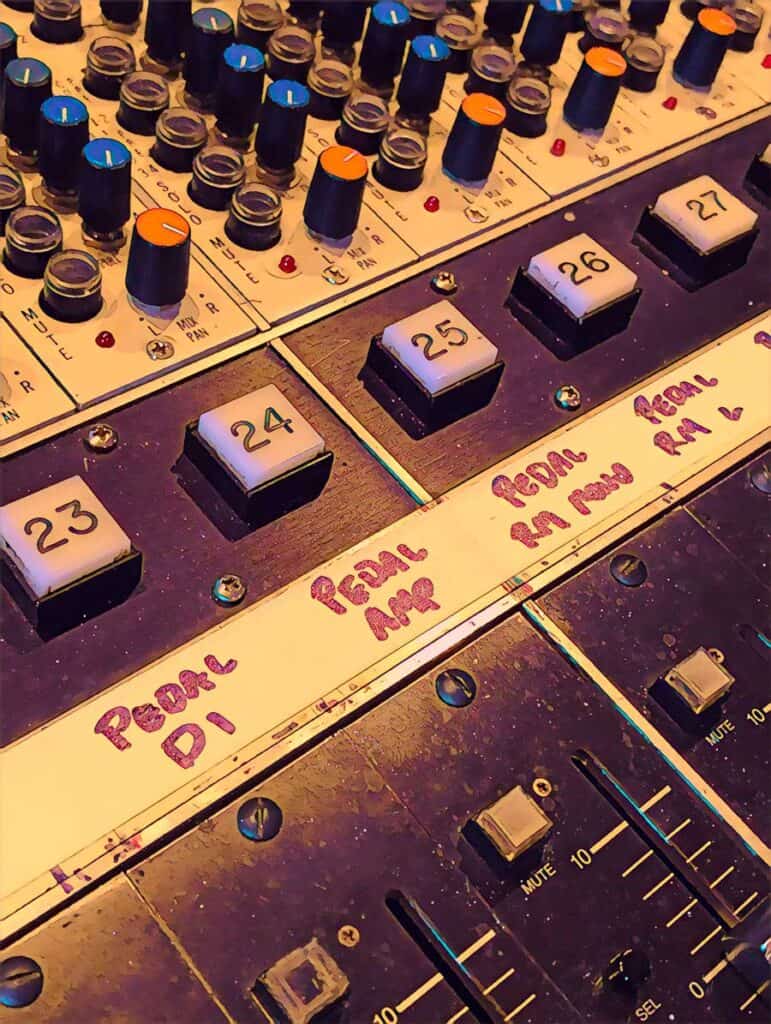
Harmonized 6ths
- Hundreds of Riffs, Licks, and More
- How To Play Sixth Intervals on the E9 Neck – Over Any Chord
- Utilizes The Pedals and Knee Levers
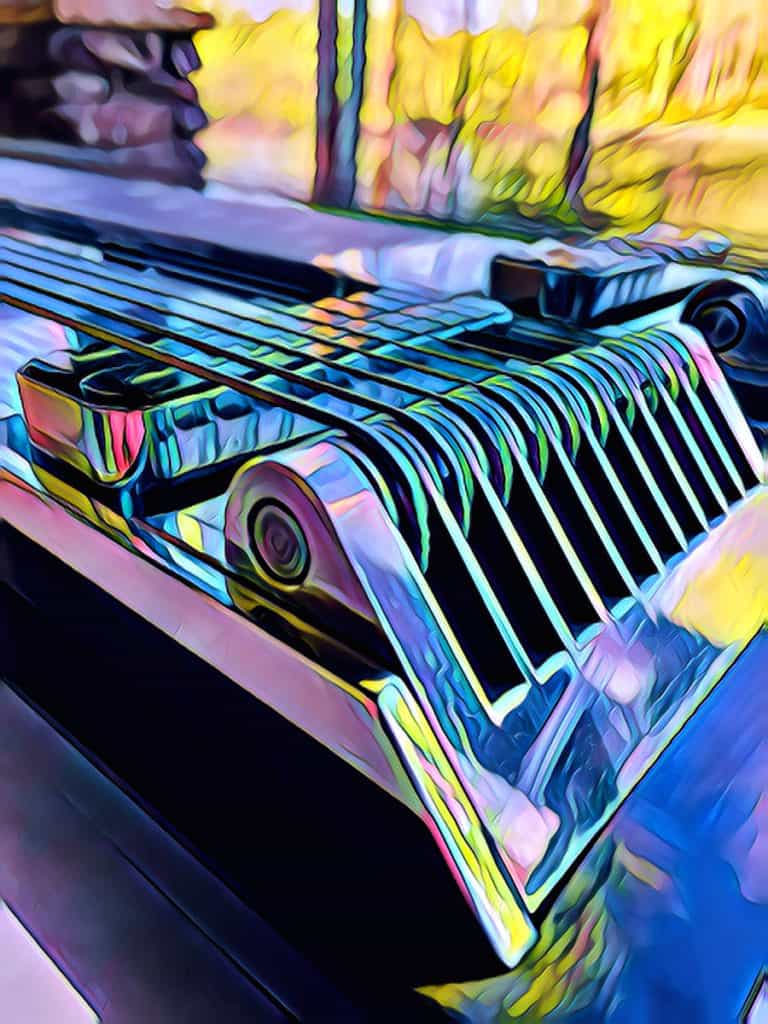
Right Hand Picking & Blocking
- An In-Depth Guide to Picking and Blocking
- Perfect Your Technique
- Includes Graphics, Illustrations, & Practice Exercises
If you’re looking for some good practice materials for the E9 tuning, check out this page…
